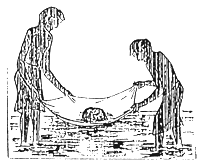TUBIFEX COLLECTION
Streams loaded heavily with organic materials are places of occurrence of different Tubifex species. Such places are in streams receiving communal waste water, water outlet of slaughterhouses, milk processing factories, etc.. Tubifex worms live in upper layer of bottom soil. Due to high oxygen requirement of Tubifex colonies, they prefer shallow parts of streams. During survey of such territories the worms are visible in bunches and scattered densely in soil. The best areas for Tubifex collection are those where frequency of the bunches are lower, but population density of worms scattered is higher.
 | 1. | For collection of worms the places containing dense populations should be selected. Upper layer of soil (not more than 5–7 cm) rice in Tubifex worms should be removed by hand or by shovel and collected in a bucket. |
 | 2. | A heap of collected mud should be placed on a hapa-material with surface area 9–10 square feet and small-particle fractions of mud should be washed out trough a fine mesh size material with continuous rinsing (shaking) cloth in water. This procedure can be done most effectively by two workers standing opposite to each other. |
 | 3. | Remaining material which was enriched in worms with rinsing of mud should be laid out in a 10 cm layer in a plastic washbasin and flattened with a piece of wood. Sand (1.0–1.5 cm) should be disposed in strata on surface of mud. Water (4–5 cm) should poured carefully in basin. As oxygen deficiency develops soon in mud covered with sand, worms will soon penetrate trough sand into water rich in oxygen. Colonies should be collected from surface and store under water current before use. |